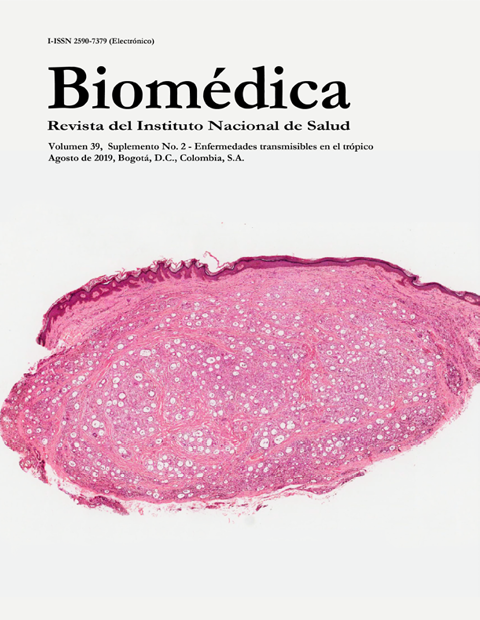Giant cells lepromatous leprosy. Diffuse dermatitis with exuberant foreign body giant cells in treated lepromatous leprosy
Abstract
Patients with lepromatous leprosy that have received treatment for many years usually get follow up biopsies for persistent skin lesions or positive bacilloscopy even if the values are lower than in the initial bacilloscopy.
We report the case of a 48-year old woman with long-standing lepromatous leprosy of 15 years of evolution, with a bacterial index of 4 in the direct smear and the initial skin biopsy.
The patient was treated with multidrug therapy for 32 months although the treatment recommended by the World Health Organization (WHO) is only for 12 months.
A skin biopsy was taken to determine if there was an active disease. We observed a diffuse dermal inflammation with numerous foreign body giant cells and vacuolated macrophages (Virchow´s cells). These cells contained granular acid-fast material that was also positive with immunohistochemistry for BCG. There were fragmented bacilli and the BI was 2.
These cells were also strongly positive for CD68. The biopsy was interpreted as a residual form of lepromatous leprosy that did not require further multidrug therapy.
We have observed similar histological profiles in several cases. The lack of clinical data makes it a histological challenge. The accumulation of lipids in these giant cells is due to bacillary destruction and fusion of vacuolated macrophages. We discuss here the role of bacillary and host lipids in the pathogenesis of lepromatous leprosy. We concluded that there was no need to extend the 12-month multidrug therapy recommended by WHO.
Downloads
References
Rodríguez G, Pinto R. La lepra. Imágenes y conceptos. Medellín: Universidad de Antioquia y Universidad de La Sabana; 2007. p. 128-36.
McDougall AC. Recent developments in the chemotherapy of leprosy. Lepr Rev. 1997;68:194-9.
Molina-Ruiz AM, Cerroni L, Kutzner H, Requena L. Immunohistochemistry in the diagnosis of cutaneous bacterial infections. Am J Dermatopathol. 2015;37:179-216. https://doi.org/10.1097/DAD.0000000000000227
Scollard DM. Pathogenesis and pathology of leprosy. Accessed: September 29, 2017. Available from: https://www.internationaltextbookofleprosy.org/sites/default/files/ITL_2_4%20FINAL_0.pdf
Kaur G, Kaur J. Multifaceted role of lipids in Mycobacterium leprae. Future Microbiol. 2017;12:315-35. https://doi.org/10.2217/fmb-2016-0173
Mattos KA, Sarno EN, Pessolani MCV, Bozza PT. Deciphering the contribution of lipid droplets in leprosy: Multifunctional organelles with roles in Mycobacterium leprae pathogenesis. Mem Inst Oswaldo Cruz. 2012;107(Suppl.1):156-66. https://doi.org/10.1590/S0074-02762012000900023
Guenin-Macé L, Simeone R, Demangel C. Lipids of pathogenic mycobacteria: Contributions to virulence and host immune suppression. Transbound Emerg Dis. 2009;56:255-68. https://doi.org/10.1111/j.1865-1682.2009.01072.x
Cruz D, Watson AD, Miller CS, Montoya D, Ochoa M-T, Sieling PA, et al. Host-derived oxidized phospholipids and HDL regulate innate immunity in human leprosy. J Clin Invest. 2008;118:2917-28. https://doi.org/10.1172/JCI34189
Degang Y, Akama T, Hara T, Tanigawa K, Ishido Y, Gidoh M, et al. Clofazimine modulates the expression of lipid metabolism proteins in Mycobacterium leprae-infected macrophages. PLoS Negl Trop Dis. 2012;6:e1936. https://doi.org/10.1371/journal.pntd.0001936
Ridley DS. Skin biopsy in leprosy. Second edition. Basle: Documenta Geigy; 1995. p. 112-21.
Majno G, Joris I. Symptoms of cellular disease: Intracellular accumulations. In: Majno G, Joris I, editors. Cells, tissues and disease. Second edition. New York: Oxford Academic Press; 2004. p. 75-112.
Kumar A, Girdhar A, Girdhar BK. Twelve months fixed duration WHO multidrug therapy for multibacillary leprosy: Incidence of relapses in Agra field-based cohort study. Indian J Med Res. 2013;138:536-40.
Ebenezer GJ, Daniel S, Norman G, Daniel E, Job CK. Are viable Mycobacterium leprae present in lepromatous patients after completion of 12 months’ and 24 months’ multi-drug therapy? Indian J Lepr. 2004;76:199-206.
Some similar items:
- Gerzaín Rodríguez, Rafael Henriquez, Shirley Gallo, César Panqueva, Histoid leprosy with giant lesions of fingers and toes , Biomedica: Vol. 35 No. 2 (2015)
- Nora Cardona-Castro, Miryan Sánchez-Jiménez, Winston Rojas, Gabriel Bedoya-Berrío, IL-10 gene promoter polymorphisms and leprosy in a Colombian population sample , Biomedica: Vol. 32 No. 1 (2012)
- Gerzaín Rodríguez, María Claudia Abaúnza, Elga Johanna Vargas, Fernando López, Leprosy and the testis , Biomedica: Vol. 32 No. 1 (2012)
- Richard Arrieta, María Teresa Garcés, Nelly Ordóñez, Santiago Fadul, Rafael Pinto, Gerzaín Rodríguez, lntrafamily leprosy outbreak , Biomedica: Vol. 21 No. 3 (2001)
- Héctor Serrano-Coll, Olinto Mieles, Calixto Escorcia, Amparo Díaz, Camilo Beltrán, Nora Cardona-Castro, A case series of pure neural leprosy in patients diagnosed in a specialized center for the control of Hansen’s disease in Colombia , Biomedica: Vol. 38 No. 2 (2018)
- Jairo Fuentes, MD, Juliana Jiménez, Gustavo Urueta, Santiago Fadul, Esperanza Meléndez, Martha Inírida Guerrero, Gerzaín Rodríguez, Leprosy in the Colombian island of Providencia , Biomedica: Vol. 40 No. Supl. 1 (2020): Mayo, Infecciones en el trópico
| Article metrics | |
|---|---|
| Abstract views | |
| Galley vies | |
| PDF Views | |
| HTML views | |
| Other views | |


























